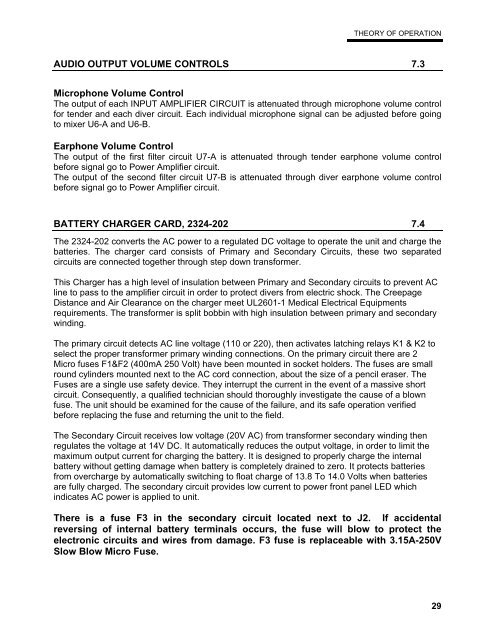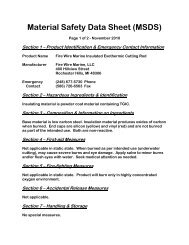Instruction Manual - Amron International Inc.
Instruction Manual - Amron International Inc.
Instruction Manual - Amron International Inc.
You also want an ePaper? Increase the reach of your titles
YUMPU automatically turns print PDFs into web optimized ePapers that Google loves.
THEORY OF OPERATIONAUDIO OUTPUT VOLUME CONTROLS 7.3Microphone Volume ControlThe output of each INPUT AMPLIFIER CIRCUIT is attenuated through microphone volume controlfor tender and each diver circuit. Each individual microphone signal can be adjusted before goingto mixer U6-A and U6-B.Earphone Volume ControlThe output of the first filter circuit U7-A is attenuated through tender earphone volume controlbefore signal go to Power Amplifier circuit.The output of the second filter circuit U7-B is attenuated through diver earphone volume controlbefore signal go to Power Amplifier circuit.BATTERY CHARGER CARD, 2324-202 7.4The 2324-202 converts the AC power to a regulated DC voltage to operate the unit and charge thebatteries. The charger card consists of Primary and Secondary Circuits, these two separatedcircuits are connected together through step down transformer.This Charger has a high level of insulation between Primary and Secondary circuits to prevent ACline to pass to the amplifier circuit in order to protect divers from electric shock. The CreepageDistance and Air Clearance on the charger meet UL2601-1 Medical Electrical Equipmentsrequirements. The transformer is split bobbin with high insulation between primary and secondarywinding.The primary circuit detects AC line voltage (110 or 220), then activates latching relays K1 & K2 toselect the proper transformer primary winding connections. On the primary circuit there are 2Micro fuses F1&F2 (400mA 250 Volt) have been mounted in socket holders. The fuses are smallround cylinders mounted next to the AC cord connection, about the size of a pencil eraser. TheFuses are a single use safety device. They interrupt the current in the event of a massive shortcircuit. Consequently, a qualified technician should thoroughly investigate the cause of a blownfuse. The unit should be examined for the cause of the failure, and its safe operation verifiedbefore replacing the fuse and returning the unit to the field.The Secondary Circuit receives low voltage (20V AC) from transformer secondary winding thenregulates the voltage at 14V DC. It automatically reduces the output voltage, in order to limit themaximum output current for charging the battery. It is designed to properly charge the internalbattery without getting damage when battery is completely drained to zero. It protects batteriesfrom overcharge by automatically switching to float charge of 13.8 To 14.0 Volts when batteriesare fully charged. The secondary circuit provides low current to power front panel LED whichindicates AC power is applied to unit.There is a fuse F3 in the secondary circuit located next to J2. If accidentalreversing of internal battery terminals occurs, the fuse will blow to protect theelectronic circuits and wires from damage. F3 fuse is replaceable with 3.15A-250VSlow Blow Micro Fuse.29



